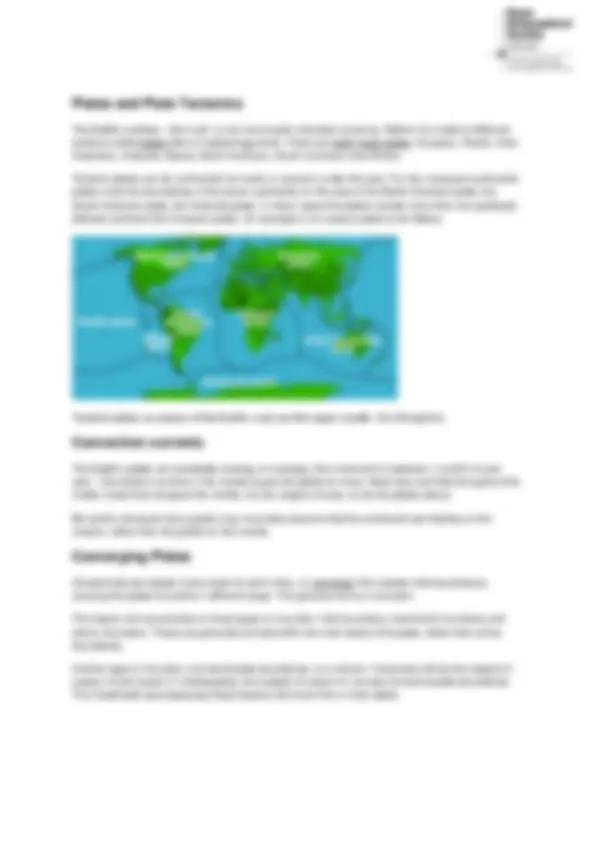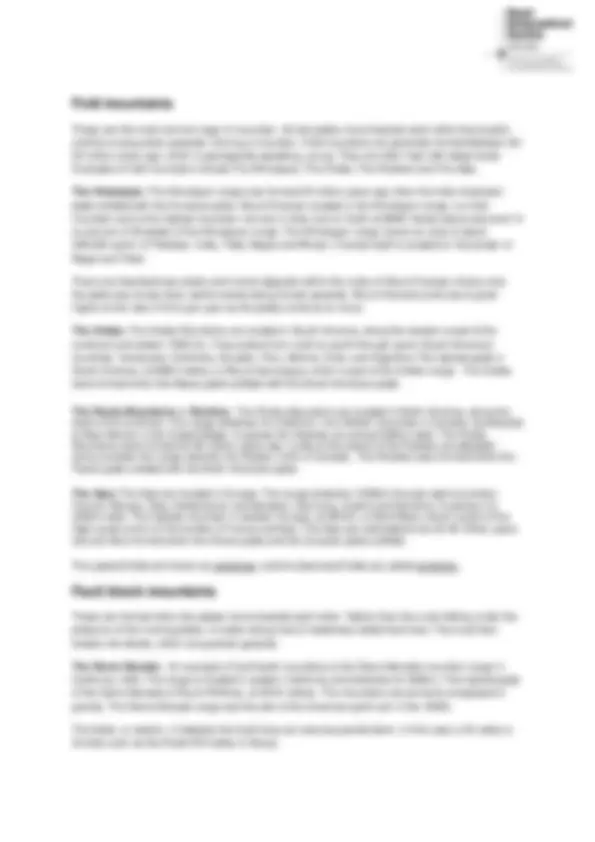





Study with the several resources on Docsity

Earn points by helping other students or get them with a premium plan


Prepare for your exams
Study with the several resources on Docsity

Earn points to download
Earn points by helping other students or get them with a premium plan
Community
Ask the community for help and clear up your study doubts
Discover the best universities in your country according to Docsity users
Free resources
Download our free guides on studying techniques, anxiety management strategies, and thesis advice from Docsity tutors
A factsheet for teachers on the topic of mountain formation. It includes vocabulary words and explanations related to the Earth's layers, plate tectonics, and the three main types of mountains: fold mountains, fault block mountains, and dome mountains. Real-world examples of each mountain type are given, along with their formation processes.
Typology: Study notes
1 / 5

This page cannot be seen from the preview
Don't miss anything!




This lesson uses the following geographical terms. These should be used and explained to pupils as the lesson is taught.
Core, mantle, crust These are the main layers of the Earth. These are described in more detail below. Molten rock Rocks that are in a liquid form. Viscous Viscosity is a measure of how thick or thin a liquid is. The higher the viscosity, the thicker the liquid; the lower the viscosity, the thinner the liquid. If a liquid is described as viscous it is thick. The mantle is viscous. Magma Magma is molten rock from the mantle. Magma is within the surface of the Earth. Magma becomes lava only once it flows out over the surface land, for example with a volcanic eruption. Plates The Earth’s crust is not one solid piece of land, but is formed of many different pieces or plates. There are eight major plates and many more minor plates. These plates move across the mantle. Plate boundary Where tectonic plates meet. Plate tectonics This is the theory of the movement of the plates that make up the Earth’s crust. Convection currents Heat from the Earth is released in currents within the mantle. This is analogous to bubbling porridge in a saucepan. The convention currents within the mantle cause the Earth’s plates to move. Faults/fault lines These are cracks in the rocks that make up the Earth’s crust. When these are evident blocks of the crust can be forced in different directions- up, down or stacked on top of one another- along the faults. Faults can occur at scales of a few centimetres or, as in the case of fault block mountains, at scales of tens of kilometres. Converge When two plates move towards each other Anticlines These are the upward folds of a fold mountain. Synclines These are the downward folds of a fold mountain. Erosion/weathering This is the process whereby rocks are worn away through the action of wind and rain. Water can also penetrate rock, and when it freezes in winter, can expand, weaken the rock and lead the rock to crumble. Rock strata Layers of rock, one above the other, that form the crust rather like the layers in a cake.
Inner core The inner core is the centre. It is primarily a solid ball of iron. It has a temperature of 5500OC- almost as hot as the outer layer of the sun, which has a temperature of 6000 OC. The inner core has a thickness of 1220km. (A distance of 1220km is equivalent to London to Ben Nevis- the UK’s highest peak- and back again). The inner core is solid due to the pressure exerted on it from the other layers. Outer core The outer core is composed of iron and nickel. Unlike the inner core, the outer core is liquid. It has a similar temperature to the inner core. Mantle This is the thickest part of the Earth, at 2900km. The mantle is viscous and composed of semi-molten rock or magma. A useful analogy is to think of the mantle having the consistency of Blu-tack , not quite a liquid and not quite a solid. It is composed of many different rocks and minerals including iron, magnesium, nickel, silicon and oxygen. Crust This is the outer layer of the Earth’s surface. It is the thinnest layer, between 0-60km. It is composed of solid rock and rests on the top layer of the mantle. It is in the crust (and the very upper layer of the mantle) that mountains are formed. When it comes to depth, think of the crust as the skin of a tomato, rather than the peel of an orange.
In order to help pupils appreciate, and visualise, the thickness of each of the layers use Google Earth. The ruler function on Google Earth can allow you to measure the distance from your school to any other location.
These are the most common type of mountain. As two plates move towards each other they buckle and the crust pushes upwards, forming a mountain. Fold mountains are generally formed between 40- 50 million years ago, which is geologically-speaking, young. They are often high with steep faces. Examples of fold mountains include The Himalayas, The Andes, The Rockies and The Alps.
The Himalayas: The Himalayan range was formed 25 million years ago when the Indo-Australian plate collided with the Eurasian plate. Mount Everest, located in the Himalayan range, is a fold mountain and is the highest mountain not only in Asia, but on Earth at 8849 metres above sea level. It is just one of 30 peaks of the Himalayan range. The Himalayan range covers an area of about 594,400 sq km of Pakistan, India, Tibet, Nepal and Bhutan. Everest itself is located on the border of Nepal and Tibet.
There are fossilised sea shells and marine deposits within the rocks of Mount Everest, where once the plate was at sea level, before slowly being forced upwards. Mount Everest continues to grow higher at the rate of 4mm per year as the plates continue to move.
The Andes: The Andes Mountains are located in South America, along the western coast of the continent and stretch 7000 km. They extend from north to south through seven South American countries: Venezuela, Colombia, Ecuador, Peru, Bolivia, Chile, and Argentina.The highest peak in South America, at 6962 metres, is Mount Aconcagua, which is part of the Andes range. The Andes were formed when the Nazca plate collided with the South American plate.
The Rocky Mountains or Rockies: The Rocky Mountains are located in North America, along the west of the continent. The range stretches for 4,830 km, from British Columbia in Canada, southwards to New Mexico in the United States. In places the Rockies are almost 500km wide. The Rocky Mountains were formed 55-80 million years ago. Limits to the extent of the Rockies are debated- some consider the range extends into Alaska, north of Canada. The Rockies were formed when the Pacific plate collided with the North American plate.
The Alps: The Alps are located in Europe. The range stretches 1200km through eight countries: France, Monaco, Italy, Switzerland, Liechtenstein, Germany, Austria and Slovenia. In places it is 250km wide. The highest mountain in western Europe, at 4810m, is Mont Blanc which is part of the Alps range and is on the border of France and Italy. The Alps are estimated to be 30-40 million years old and were formed when the African plate and the Eurasian plate collided.
The upward folds are known as anticlines, and the downward folds are called synclines.
These are formed when two plates move towards each other. Rather than the crust folding under the pressure of the moving plates, it cracks along lines of weakness called fault lines. The crust then breaks into blocks, which are pushed upwards.
The Sierra Nevada : An example of fault block mountains is the Sierra Nevada mountain range in California, USA. The range is located in eastern California and stretches for 640km. The highest peak of the Sierra Nevada is Mount Whitney, at 4418 metres. The mountains are primarily composed of granite. The Sierra Nevada range was the site of the American gold rush in the 1840s.
The block, or section, in between the fault lines can also be pushed down. In this case a rift valley is formed, such as the Great Rift Valley in Kenya.
Dome mountains are the result of a great amount of molten rock (magma) pushing its way up under the Earth’s crust. Without actually erupting onto the surface, the magma pushes up the overlaying rock strata which then bulge upwards. Eventually the magma cools and forms hardened rock.
The Black Hills mountain range: An example of a dome mountains is the Black Hills mountain range in South Dakota, USA. The highest peak in the range is Harney peak at 2208 metres. Mount Rushmore, also in the Black Hills, is another example a Dome Mountain, at 1745 metres. It is famous for having the four American presidents, George Washington, Thomas Jefferson, Theodore Roosevelt, and Abraham Lincoln carved into its face. The carving took 14 years and was completed in